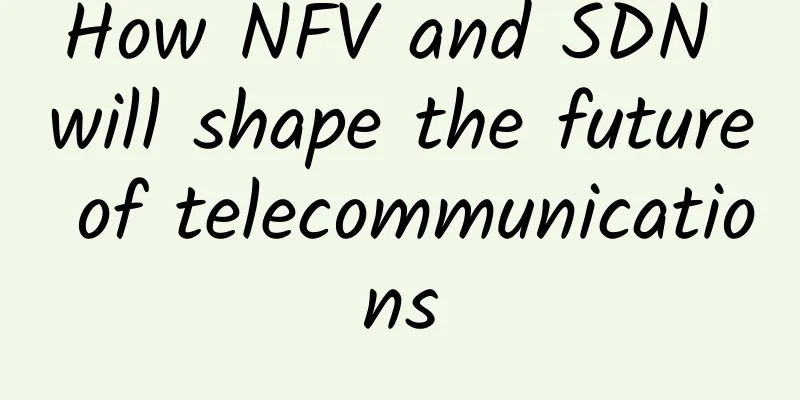How NFV and SDN will shape the future of telecommunications

|
The Internet has been developed for decades. Faced with the surge in data traffic and the impact of OTT services, the transformation of traditional telecommunications networks is imminent. However, due to the emergence of technologies such as software-defined networking (SDN) and network function virtualization (NFV), network operators have gradually ignored the importance of network transformation. They seem to think that these emerging technologies can solve all current problems. Most network operators don’t even know how to achieve transformation.
Although SDN and NFV can help operators in their transformation process, operators must find the right way to view and utilize SDN and NFV. In the future, operator profits will be based on maximizing average revenue per user and then minimizing costs. This is considered the model for the success of mobile services and is likely to be the model for video streaming services as well. It must be accepted as the first step towards profit planning and the introduction of new network technology innovations in the future of telecommunications. Driving profitability across the board is a top priority for operators. The reason is simple: OpEx costs for operators are higher than CapEx, and in the OpEx space, attracting and retaining customers is the single largest cost. Even the best service lifecycle management system in the world won’t help operators hit sales targets, and it will have limited impact on reducing churn. Sticky services, those that are self-perpetuating in terms of promise, are the real key. A cloud-native approach to NFV and SDN We already know that the benefits of replacing physical equipment with hosted functions are limited in terms of Capex and Opex, so the real value of NFV is in creating cloud-hosted, composable functions. Forget the terms associated with NFV, such as MANO, virtualized infrastructure manager, virtual network function manager, and focus on simply orchestrating useful functions into services using traditional cloud tools and elements. Most cloud-hosted functions will create over-the-top (OTT) services, which is where most operators believe the real benefits of the future of telecom will be. The range of capabilities that can be orchestrated into OTT services depends on the operator’s specific market focus and their commitment to OTT services. In some markets, telecom operators have been involved in OTT services for many years and these operators already have specific opportunities to target and even some technologies. Broadly speaking, the video and advertising aspects of the business are what operators think they are best at. Home security and facility control will be the next industry they will enter. All of these services have the advantage of being profit centers from the beginning because they can be launched without excessive first costs. Flexible orchestration of new functions is the future of SDN in telecommunications. If a new service is a fabric of functions and connections hosted in nearby edge or metro data centers, it is a challenge to bring all the pieces together using current network technology. This is especially true if the network also needs to be fully secure and cost-effective. SDN is already part of the cloud data center, so it is logical to assume that as service function hosting is expanded and involves multiple data centers, SDN will be expanded to support larger tasks. Creating and maintaining these connections must keep pace with failover, scaling, and redeployment decisions caused by service changes. Therefore, a common orchestration approach for the data center and WAN is important. SDN can do this because it already does much of the necessary work within the data center. Evaluating Telecom Cost Reductions In terms of cost, the goal for operators is to take full advantage of the technology that makes it possible for NFV and SDN to work in harmony. The agility that these two technologies can provide depends on the orchestration tools, which mainly provide near zero-touch capabilities. Because SDN and NFV have software APIs for configuration, they are suitable for lifecycle orchestration, where some plug-ins or auxiliary controllers may be needed to control the network of physical devices. NFV and SDN cannot promise cost reductions without service lifecycle automation. However, it is unclear how this can be achieved. ETSI groups working on zero-touch automation and the AT&T ECOMP SDN project have open sourced their work. It is too early to say if or when any of these efforts will pay off. The good news is that the future of telecommunications is shifting, including a cloud-native vision for NFV and SDN. Assuming that NFV and SDN are deployed following cloud principles and are more tightly coupled with network hardware than standalone network standard protocols, many service lifecycle automation issues can be solved with cloud orchestration tools such as Kubernetes. A cloud-native perspective is key to all of this, both in terms of new revenue and cost reduction. If NFV and SDN follow cloud-centric deployment principles, rather than the more traditional network-centric approach that underlies both technologies, the revenue growth and cost management elements of both technologies can be combined with an overarching lifecycle automation vision. This will allow SDN and NFV to continue to grow in the telecom space of the future. Without a cloud-native perspective, neither technology is likely to achieve the desired results. Original link of this article: https://searchtelecom.techtarget.com/tip/How-NFV-and-SDN-could-shape-the-future-of-telecom |
<<: WiFi is getting slower and slower. Here’s how to revive it
>>: The key to moving towards multi-cloud is management tools
Recommend
"Small body but great wisdom" Huawei helps Wanyang digitalize small and micro parks
[51CTO.com original article] How many "chara...
2017 Inspur Cisco Network Strategy Conference is about to be held
On November 15, 2017, Inspur Cisco Network will h...
Ministry of Industry and Information Technology: 5G users account for more than 30% of my country's total
On October 26, the Ministry of Industry and Infor...
Illustrated Network: Access Control List (ACL), which is as powerful as a firewall
In the world of computer networks, one of the mos...
Interviewer: Tell me how Nginx handles requests? Why doesn't Nginx use a multi-threaded model? What are the Nginx load balancing algorithms? What are forward and reverse proxies?
Interviewer: Can you tell me how Nginx handles re...
Wi-Fi 7: What is it and when can you expect it to arrive?
[[380191]] Wi-Fi 7 is expected to have higher dat...
What is the relationship between API, ESB, ServiceMesh, and microservices?
Introduction I mentioned before that I would like...
Google withdraws from 2021 MWC World Mobile Communications Conference
The annual MWC World Mobile Communications Confer...
The Ministry of Industry and Information Technology revised the project plan for industry standards such as artificial intelligence
According to the overall arrangement for the form...
Practicing ESG, Shengye continues to promote sustainable development of supply chain technology
ESG is an acronym for Environment, Society and Go...
What is the use of "5G+AI"? This comic tells you the answer...
[[425909]] This article is reprinted from the WeC...
Mathematical formula could help 5G networks share communication frequencies efficiently
Researchers at the National Institute of Standard...
One million new 5G base stations will be built next year. Is that a lot?
The latest news shows that my country has built a...
5G enables thousands of industries, and deepening transformation calls for cross-domain collaboration
According to the Economic Operation of the Commun...









